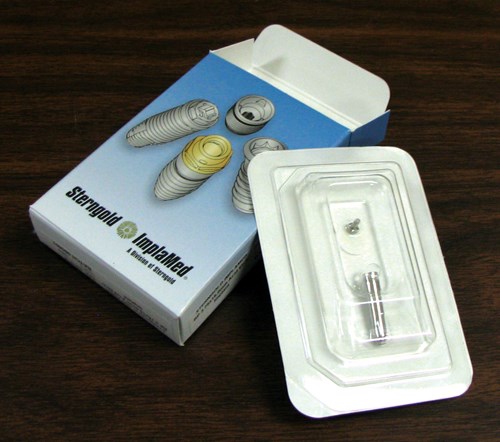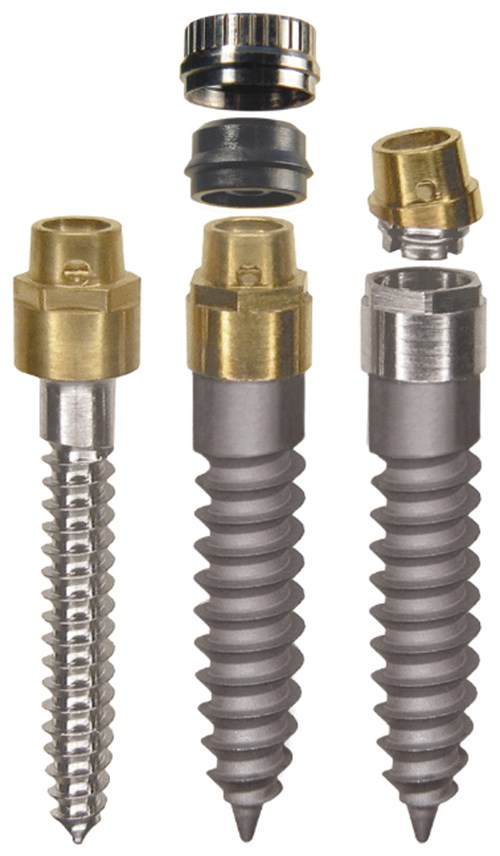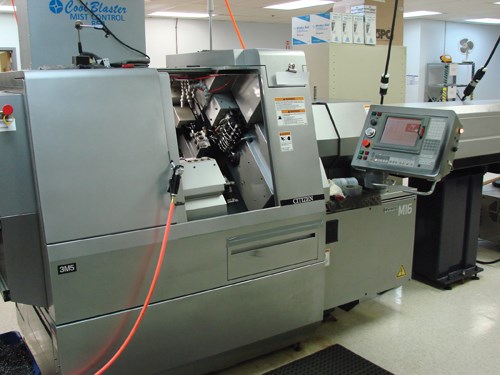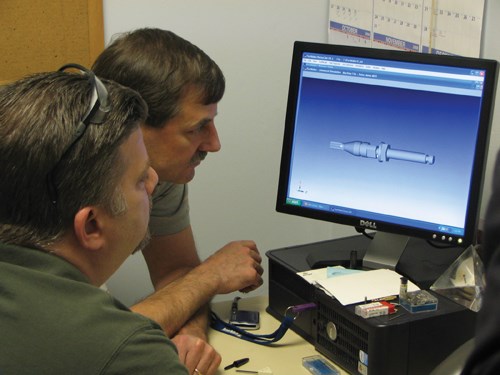Software Bridges Gap For Dental Implant Manufacturer
This dental implant manufacturer has found the right combination of technology and personnel to help implement its changing philosophy rooted in the control of its manufacturing processes.
With proper planning, knowledgeable personnel and access to the right tools, a company can significantly reduce outsourcing expenses by bringing certain operations in-house. For Sterngold (Attleboro, Massachusetts), a manufacturer of dental implants and restorative components, a change in company philosophy was the catalyst for such a move as management made the decision to bring back manufacturing of the majority of the company’s components.
In an effort for continuous improvement and to achieve optimum efficiency, Sterngold embarked on a program 2 years ago to expand internal manufacturing capabilities. Director of Operations Lee Clermont and Senior Engineer Bruce Seavey explained that until that point, the company relied on several outside vendors. “We saw a big benefit to shifting to in-house manufacturing to provide the ability to do rapid prototyping and bring new products to market more quickly,” says Mr. Clermont.
“Lead times also played a big part in our initiations,” Mr. Clermont says. “Some of our parts require small manufacturing runs, and the ability to schedule our own jobs allows for more flexible production.”
Adding Resources
The management realized that it needed additional staff before it could make the change to in-house production and so hired designer and engineer Bruce Seavey and machinist John Souza. “These appointments have been crucial to our new approach,” Mr. Clermont says. “They are both experienced in their field, of course, but the main benefit has been the way in which they work together to develop products that not only meet our customers’ needs but that can also be manufactured cost-effectively.”
Sterngold installed the first of its new machines early in 2006. Mr. Clermont and Mr. Seavey chose Citizen equipment because they believed it would allow faster setups—an essential requirement given the number of small runs being produced. The second machine followed in November of that year, and a third in 2007. The company’s current plan is to add a new machine each year as production increases. External machining is now down to around 10 percent of total production.
Software Solution
Beyond the machines, a significant reason why Sterngold has had so much success with its transition to in-house production has been the implementation of Delcam’s PartMaker software. The main components the company machines are its ERA family of resilient dental attachments. The range includes a number of angled attachments that are needed to give a strong hold where the underlying bone is thinner. Creating these complex angles would be extremely difficult with manual programming on the machines, even if multiple setups were used. In contrast, with PartMaker the company can create a program to make the parts in one operation and run a simulation to check what will actually happen on the machine.
“With PartMaker and the Citizen machines, we can not only produce the complete part on one machine but also use the two spindles to minimize the cycle time,” Mr. Souza says. “Using conventional methods, we would need two machines and a special fixture on the second machine. With the Citizen machine, we can produce a complete part in about 4 minutes. It would take that long on each of the two machines with a conventional approach. In addition, making parts in one operation is more accurate than using fixtures.”
As well as being small and having to be machined to tight tolerances, the design of the attachments makes them difficult to hold in the machine. Together, these factors mean that each pass has to be as little as one or two thousandths of an inch. “That’s a lot of tool paths to calculate without any software,” according to Mr. Souza. “There are also tough shapes such as threads on tapered radii that are difficult to work out manually but are easy to program in the
software.”
Mr. Souza admits that although Sterngold purchased PartMaker at the same time as its first Swiss machine, he did not start using it immediately. “We started out programming on the machines,” he says, “but we quickly realized that if Bruce (Seavey) and I collaborated in writing the programs, we’d be far more efficient.” Most of the programming is done off of solid models. Mr. Seavey draws the solid model in SolidWorks and then downloads it into PartMaker. Then Mr. Souza assists in implementing the different tools to use before plugging the program into the machine.
The ease of use of the software enabled Sterngold to ramp up production on the new machine more quickly than expected. “We scheduled three jobs to be completed in the first month after installation but completed them all in a week,” Mr. Souza remembers.
Another benefit of the software is the reduction in the time and difficulty of setting up the machines. “Because of our short runs, we are usually setting up a different part on at least one machine every day,” Mr. Souza says. “By doing our planning and testing on the software, we can reduce the machine time needed for setups by at least 40 percent.
“PartMaker has also allowed us to have our machine operators setting up our equipment for different parts,” he adds. “The software tells them which tools to load into the various positions on the machine. They don’t need to run any production trials or make any changes to the program as it has already been proved out on the software.”
Positive Results
Sterngold is sold on the reduction in setup time that the software has delivered. Mr. Seavey explains, “It’s easy to program. Any reduction is worth it, but with this software we’ve cut setup time almost in half. When you write a part program, it will tell you if you have any errors or tool crashes. While the machine’s running one part, we can be writing a program for another part. We’ll see errors beforehand and fix them before the part ever gets onto the machine.” Sterngold always does a dry run with the software to make sure there are no tooling issues and there will be no crashes. When a machine is free and is ready for a setup, most of the work is already finished. The operator plugs the program into the machine and runs a test part in brass with no coolant to watch the process and do any necessary fine-tuning. Mr. Seavey adds, “With this software, it’s almost like having an additional machine just for setups.”
Mr. Clermont explains how the benefits of the software work their way through the shop. “We run two shifts each day, but John can only work one of those. It’s his responsibility to get all three of the machines set up and running during the day and also make sure they’re ready to go for the night shift. Before we had the software, our machine operators weren’t able to do any setups. But with PartMaker, we can give the operators the programs and it turns them into setup people. In essence, most of the setup has already been done by Bruce and John on a computer.”
Mr. Seavey continues, “Without our preliminary work, the operator wouldn’t know how to program the codes on the machine. The software provides a shopping list of what tools to use. All the operator needs to do is put the tools into the machine. Typically the machine operator does just that; he operates the machine. He may know how to change a tool if it breaks, he keeps the bar feeder loaded, he hits the button, and he checks the parts coming off the machine. With much of the work done off-line, that operator now becomes a setup person as well.”
By assembling the right combination of technology and personnel, Sterngold has found a way to once again take control of its manufacturing processes and positively affect its bottom line. Planning and teamwork have been instrumental in making it happen.
Related Content
Meeting Stringent Cleaning Goals With Modular Ultrasonic System
A knee implant manufacturer implements an advanced cleaning system that meets its tight cleaning requirements, including documenting, validating and tracing the entire cleaning process.
Read MorePhotochemical Etching Explained
This subtractive metal fabrication process is an alternative to traditional methods which enables designers to create thin metal parts with intricate shapes to micron-level precision without leaving behind burrs.
Read MoreThe Value of Swiss-Types Milling Rectangular Medical Parts
High-speed spindle technology was key to effective milling of small cardiac monitoring components complete on a CNC sliding-headstock machine platform instead of running them across two mills.
Read MoreThe Control’s Role in Machining Complex Parts
This company that produces medical implants finds value in the CNC for its turn-mill equipment that helps speed setups and simplify programming when producing intricate parts complete.
Read MoreRead Next
Medical Machining Made Simpler
Medtronic Powered Surgical Solutions produces power surgical motors, tools and attachments. CAM with knowledge-based machining capabilities helps them program low volume, complex parts processed on multi-tasking screw machines.
Read MoreSoftware Meets Shop's Multitasking Machine Programming Needs
Structure Medical is not new to the medical supply industry; it is a spin-off of a company called Inovo, which is a manufacturer of oxygen regulators used in hospitals, nursing homes and the like. Inovo’s principals had been looking for growth opportunities.
Read MoreDo You Have Single Points of Failure?
Plans need to be in place before a catastrophic event occurs.
Read More












.jpg;maxWidth=300;quality=90)




.jpg;maxWidth=300;quality=90)








